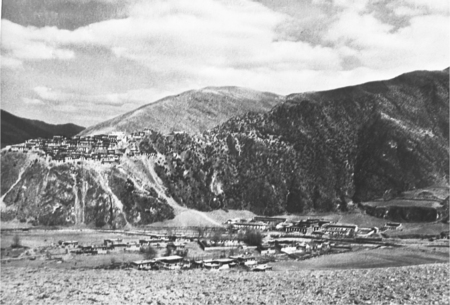 6
6The Ceding of Dzongsar
Monastery
 6
6IN 1929, ALMOST TWO YEARS AFTER he had again entered in retreat, Chökyi Wangchug received a message from Chökyi Lodrö, the elder reincarnate, affirming his wish to return to Kathog. Chökyi Wangchug immediately ended his retreat and returned to his own residence to meet with him.

Dzongsar monastery. (List of Illustrations 6.1)
Informing himself better about the motives for which Chökyi Lodrö had stated he was tired and was insisting on returning to Kathog, he learned of the incessant quarreling inside the monastery residence between the administrator of Chökyi Lodrö, Shinkyong,1 and his own administrator, Ngadrag.2
The two masters were utterly free of conflicting points of view, and it was unlikely that they could be influenced by disputes created by others. However, they understood that their administrators were in the grip of the gyalgong spirits3 that destroy samaya. The two reincarnations agreed that if they were to remain together in the same residence, their subordinates, though linked by samaya, could become the source of conflicts so great as to undermine their spiritual relationship with each other.
Although no possibility existed of a schism between the two lamas, the great khenpo Jamgyal4 and Chagö Tobden5 intervened, seeking to settle the controversy and to facilitate an agreement between the two administrators.
Thus it was decided that Chökyi Lodrö would remain in the current residence, that Chökyi Wangchug would move to a new palace in the monastic residence of Derge Gönchen,6 and that the two would divide between them a number of sacred objects and relics that had belonged to the preceding reincarnation.

Chagö Tobden. (List of Illustrations 6.2)
The Gagu hermitage, where Khyentse Chökyi Wangchug received the Lamdre Lobshe teachings from Jamgyal Rinpoche. (List of Illustrations 6.3)
The two tulkus retained their pure spirit. The younger returned to practicing in retreat as before, renouncing completely the idea of building a new residence. Instead, his administrator, his father Jamyang Trinle, and others who desired a palace at the residence made preparations to have him reside in the capital of Derge.
While the young tulku was practicing in the Pemashel7 cave, someone—it was not determined whom—offered him poisoned food, seriously endangering his life. Chökyi Lodrö rushed to his side, administered medicine, and practiced long-life rituals, and thus succeeded in saving him. Following these events, Chökyi Wangchug was compelled to move to the capital of Derge, where he established temporary residence in the central part of the Derge Gönchen monastery, in the large and beautiful bedchamber of the old abbot Samten Lodrö.8 He remained there for several months until his health improved, leaving as soon as he recovered in full for Makhog Tragra9 to meet the shabdrung,10 from whom he received various profound teachings.
Though his official residence was now Derge Gönchen, he journeyed to Dzogchen monastery at Rudam and to the hermitage of Gyawo,11 where he received deep teachings from Kunga Palden12 and others. In particular, he followed the omniscient Zhenga13 Rinpoche to the retreat place of Nephu14 and other sites, where he received from him The Thirteen Great Writings15 and the Gyutrul16 mahāyoga cycle, which he then studied for many years.
He received the initiations, explanations, and the particular methods of the profound instructions found in the oral traditions of the Ancients.17 Freed from every doubt, he realized concretely the results of the essential points of practice. Moreover, he obtained from many realized sages a great number of instructions and profound essential methods, so that he himself became a great secret treasury of the teachings of the oral tradition and of termas,18 of both the Ancient and Modern traditions,19 regardless of the limits of the schools.